Architecture of Bengal
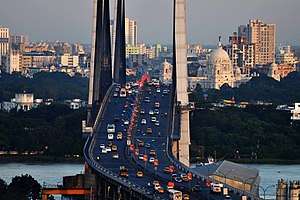
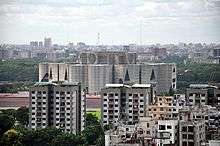
| Part of a series on |
| Bengalis |
|---|
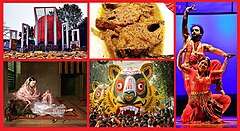 |
|
Bengali homeland |
|
The architecture of Bengal, which comprises the modern country of Bangladesh and the Indian state of West Bengal, has a long and rich history, blending indigenous elements with influences from different parts of the world. Bengali architecture includes ancient urban architecture, religious architecture, rural vernacular architecture, colonial townhouses and country houses, and modern urban styles. The bungalow style is a notable architectural export of Bengal. The corner towers of Bengali religious buildings were replicated in medieval Southeast Asia. Bengali curved roofs were copied by the Mughals in North India.
Bengal is not rich in good stone for building, and traditional Bengali architecture mostly uses brick and wood, often reflecting the styles of the wood, bamboo and thatch styles of local vernacular architecture for houses. Decorative carved or moulded plaques of terracotta (the same material as the brick) are a special feature.
Antiquity
Urbanization is recorded in the region since the first millennium BCE. This was part of the second wave of urban civilization in the Indian subcontinent, following the decline of the Indus Valley Civilization. Ancient Bengal was part of a network of urban and trading hubs stretching to Ancient Persia. The archaeological sites of Mahasthangarh, Paharpur, Wari-Bateshwar ruins, Chandraketugarh and Mainamati provide evidence of a highly organized urban civilization in the region. Terracotta became a hallmark of Bengali construction, as the region lacked stone reserves. Bricks were produced with the clay of the Bengal delta.
Ancient Bengali architecture reached its pinnacle during the Pala Empire, especially in the construction of viharas, temples and stupas. Pala architecture influenced Tibetan and Southeast Asian architecture. The most famous monument built by the Pala emperors was the Grand Vihara of Somapura, now a UNESCO World Heritage Site. Historians believe Somapura was a model for the architects of Angkor Wat in Cambodia.[1]
Medieval and early modern periods
Hindu and Jain
Most temples surviving in reasonable condition date from about the 17th century onwards, after temple building revived; it had stopped after the Muslim conquest in the 13th century.[2] The roofing style of Bengali Hindu temple architecture is unique and closely related to the paddy roofed traditional building style of rural Bengal.[3] Roofing styles include the jor-bangla, do-chala, char-chala, at-chala, deul, ek-ratna, pancharatna and navaratna. Bishnupur in West Bengal has a remarkable set of such temples which being built from the Malla dynasty are examples of this style. Most of these temples are covered on the outer surface with terra cotta reliefs which contains plenty of secular materials making these important to reconstruct the social structure from these times.
The temple structures contain gabled roofs which are colloquially called the chala, For example, a gabled roof with an eight sided pyramid structured roof will be called "ath chala" or literally the eight faces of the roof. And frequently there is more than one tower in the temple building. These are built of laterite and brick bringing them at the mercy of severe weather conditions of southern Bengal. Dakshineswar Kali Temple is one example of the Bhanja style while the additional small temples of Shiva along the river bank are example of southern Bengal roof style though in much smaller dimension.
.jpg) A deul Jain temple
A deul Jain temple
- A Pancharatna temple
- A ritual platform
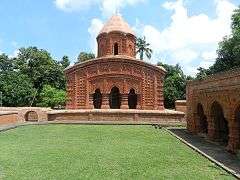 Ram Chandra Temple on Guptipara
Ram Chandra Temple on Guptipara Jor-bangla features a curved Do-chala style roof
Jor-bangla features a curved Do-chala style roof Evolution of Temple Architecture in Bengal
Evolution of Temple Architecture in Bengal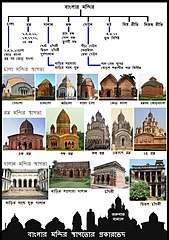 Classification of Bengal Temple Architecture 1
Classification of Bengal Temple Architecture 1 Classification of Bengal Temple Architecture 2
Classification of Bengal Temple Architecture 2
Islamic
Islamic influence in the Bengali architecture can be seen from the 12th century. The oldest surviving mosque was built during the Delhi Sultanate. The mosque architecture of the independent Bengal Sultanate period (14th, 15 and 16th centuries) represents the most important element of the Islamic architecture of Bengal. This distinctive regional style drew its inspiration from the indigenous vernacular architecture of Bengal, including curved chala roofs, corner towers and complex floral carvings. Sultanate-era mosques featured multiple domes or a single dome, richly designed mihrabs and minbars and an absence of minarets. While clay bricks and terracotta were the most widely used materials, stone was used from mines in the Rarh region. The former Adina Mosque was the largest mosque ever built in the medieval Indian subcontinent. The surviving Sixty Dome Mosque is now a UNESCO World Heritage Site. The Sultanate style also includes gateways and bridges. The style is widely scattered across the region.[4]
Mughal Bengal saw the spread of Mughal architecture in the region, including forts, havelis, gardens, caravanserais, hammams and fountains. Mughal Bengali mosques also developed a distinct provincial style. Dhaka and Murshidabad were the hubs of Mughal architecture. The Mughals copied the do-chala roof tradition in North India.[5]
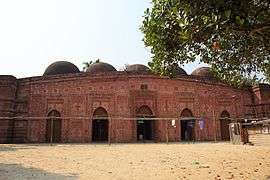 A multi-domed Sultanate era mosque
A multi-domed Sultanate era mosque A single domed Sultanate era mosque
A single domed Sultanate era mosque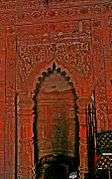 A Bengali mihrab
A Bengali mihrab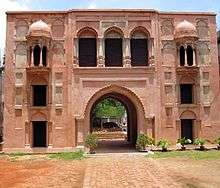 A 17th century haveli in Old Dhaka
A 17th century haveli in Old Dhaka The Naulakha Pavilion at the Lahore Fort in Pakistan displays the distinct Bengali Do-chala style roof.[6]
The Naulakha Pavilion at the Lahore Fort in Pakistan displays the distinct Bengali Do-chala style roof.[6]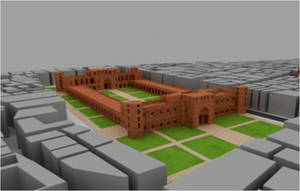 3D model of a reconstructed Bara Katra (Great Caravanserai of Dhaka) from the Mughal era
3D model of a reconstructed Bara Katra (Great Caravanserai of Dhaka) from the Mughal era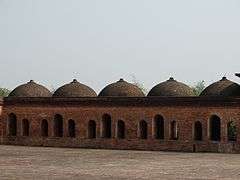 Mughal era domes in Murshidabad
Mughal era domes in Murshidabad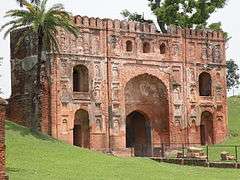 A Sultanate era gateway
A Sultanate era gateway A Sultanate era standalone minaret
A Sultanate era standalone minaret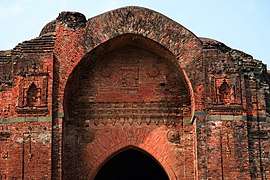 A Sultanate era arch
A Sultanate era arch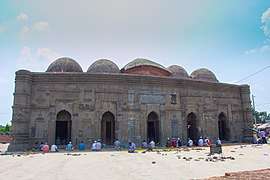 A Sultanate era stone mosque
A Sultanate era stone mosque- An early Sultanate era mosque and tomb
- The Sultanate era Adina Mosque
 Interior of a Sultanate era imperial mosque
Interior of a Sultanate era imperial mosque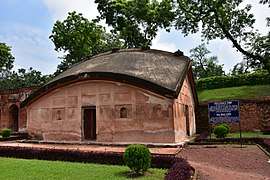 A Sultanate era mausoleum
A Sultanate era mausoleum A Sultanate era stone mosque
A Sultanate era stone mosque.jpg) A Mughal era bride in Sonargaon
A Mughal era bride in Sonargaon South-East Gate of Lalbagh Fort in 1875
South-East Gate of Lalbagh Fort in 1875
Colonial period
The period of British rule saw wealthy Bengali families (especially zamindar estates) employing European firms to design houses and palaces. The Indo-Saracenic movement was strongly prevalent in the region. While most rural estates featured an elegant country house, the cities of Calcutta, Dacca, Panam and Chittagong had widespread 19th and early 20th century urban architecture, comparable to London, Sydney or Auckland. Art deco influences began in Calcutta in the 1930s.
Bungalow
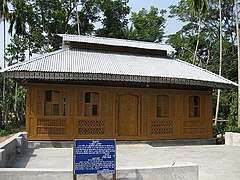
The origin of the bungalow has its roots in the vernacular architecture of Bengal.[7] The term baṅgalo, meaning "Bengali" and used elliptically for a "house in the Bengal style".[8] Such houses were traditionally small, only one storey and detached, and had a wide veranda were adapted by the British, who used them as houses for colonial administrators in summer retreats in the Himalayas and in compounds outside Indian cities.[9] The Bungalow style houses are still very popular in the rural Bengal. In the rural areas of Bangladesh, it is often called “Bangla Ghar” (Bengali Style House). The main construction material used in modern time is corrugated steel sheets. Previously they had been constructed from wood, bamboo and a kind of straw called “Khar”. Khar was used in the roof of the Bungalow house and kept the house cold during hot summer days. Another roofing material for Bungalow houses has been red clay tiles.
Modernism
Art Deco influences continued in Chittagong during the 1950s. East Pakistan was the center of the Bengali modernist movement started by Muzharul Islam. Many renowned global architects worked in the region during the 1960s, including Louis Kahn, Richard Neutra, Stanley Tigerman, Paul Rudolph, Robert Boughey and Konstantinos Doxiadis. Louis Kahn designed the Jatiyo Sangshad Bhaban, the preeminent symbol of modern Bangladeshi architecture. The cityscapes of modern Bengali cities are dominated by midsized skycrapers and often called concrete jungles. Architecture services form a significant part of urban economies in the region, with acclaimed architects such as Rafiq Azam.
In 2015, Marina Tabassum and Kashef Mahboob Chowdhury were declared winners of the Aga Khan Award for Architecture for their mosque and community center designs respectively, which were inspired by the region's ancient heritage.[10]
- An art deco building in Chittagong
 Bangladeshi rooftop garden
Bangladeshi rooftop garden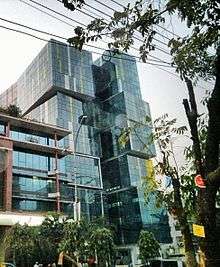 A Rubik's cube style building in Dhaka
A Rubik's cube style building in Dhaka Bengali alphabets on the ceiling of Kolkata Airport
Bengali alphabets on the ceiling of Kolkata Airport
See also
Notes
- ↑ Ronald M. Bernier (1997). Himalayan Architecture. Fairleigh Dickinson Univ Press. p. 22. ISBN 978-0-8386-3602-2.
- ↑ Michell, 156
- ↑ 3.http://www.kamat.com/kalranga/wb/wbtemps.htm
- ↑ Perween Hasan; Oleg Grabar (2007). Sultans and Mosques: The Early Muslim Architecture of Bangladesh. I.B. Tauris. ISBN 978-1-84511-381-0.
- ↑ Andrew Petersen (2002). Dictionary of Islamic Architecture. Routledge. p. 34. ISBN 978-1-134-61365-6.
- ↑ Dani, Ahmad Hasan; Masson, Vadim Mikhaĭlovich; Unesco (2003-01-01). History of Civilizations of Central Asia: Development in contrast : from the sixteenth to the mid-nineteenth century. UNESCO. ISBN 9789231038761.
- ↑ bungalow > common native dwelling in the Indian province of Bengal
- ↑ Oxford English Dictionary, "bungalow"; Online Etymology Dictionary
- ↑ Bartleby.com
- ↑ http://www.dhakatribune.com/feature/2016/10/03/2-bangladeshi-projects-among-aga-khan-award-for-architecture-winners/
References
Further reading
- Michell, George (Ed.), Brick Temples of Bengal - From the Archives of David McCutchion, Princeton University press, New Jersey, 1983

-Jerusalem-Temple_Mount-Dome_of_the_Rock_(SE_exposure).jpg)